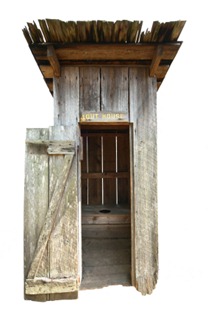Posted July 26, 2011
Hosting: In House or Outhouse
One of the decisions that need to be made when deploying a system to a production environment is where that production environment will be served from. Typically we are faced with two main options. In house or out of house (or you may want to call it the "cloud"). This decision may well be one of the more important ones you make and can easily be a reason behind system failure.
The name “cloud” has been borrowed from the concept of cloud computing.
Cloud computing means Internet ('Cloud') based development and the use of computer technology ('Computing'). It is a style of computing where IT-related capabilities are provided “as a service”, allowing users to access technology-enabled services "in the cloud" without knowledge of, expertise with, or control over the technology infrastructure that supports them. It is a general concept that incorporates software as a service, Web 2.0 and other recent, well-known technology trends, where the common theme is reliance on the Internet for satisfying the computing needs of the users. For example, Google Apps provides common business applications online that are accessed from a web browser, while the software and data is stored on the servers.
Lets look at a few pros and cons. In house hosting is probably fine if you do not require any external access to your system. Typically these sorts of tools are inexpensive to install or come bundled with your Windows Server. They are simple to setup and integrate with your Active Directory (AD) or Windows Users and just seem to work “Out of the box”. You must understand the concepts of availability, redundancy and have a super tight backup system, but most small organisations will get away with this type of deployment with a little help from their IT team or supplier.
With in house hosting Managers and users have the ability to RDP into their network and access the system, but this is where the problems start. See, until the all mighty National Broadband Network (NBN) is providing super speeds, then most offices have ADSL as their Internet connection. A lucky few may have access to faster networks, but in reality slow ADSL is the norm and the slow speeds really mess with your experience of a system when accessing remotely and a majority of the time are the reason they are not used or they fail. (I am a big fan of the NBN.)
The solution is hosting with a professional web host or in the cloud (as we love calling it). This comes with it’s own set of problems, however, these problems are far less than those of hosting in house. You can get good hosts and also really crappy ones. You need to do your homework and a good gauge is the price. The cheap ones are typically the ones who are smaller and have less infrastructure or host overseas and the expensive ones have all the bells and whistles and have guaranteed uptimes and disaster recovery plans in place.
If you host outside of your office you need to make sure that the host you are using guarantees that your system will be backed up and looked after. We are now also probing into trust issues and understandably many businesses do not trust just anyone with their systems as they can hold important or sensitive information. All the more reason to source a reputable hosting company!
So the question still remains. What is best for your organisation? You need to draw up the pros and cons mentioned above and think about availability, remote access, support, licensing, security and backups. Then ask yourself what solution is best for you and what variables are most important to you. If you need some advice feel free to contact Konsult and we will be able to assist and advise.